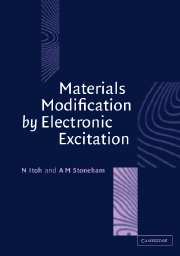Book contents
- Frontmatter
- Contents
- Preface
- 1 Concepts: Excitation, polarons and electronic structure
- 2 Energy deposition and redistribution in solids
- 3 Electron–lattice coupling and its consequences
- 4 Self-trapping
- 5 Local lattice modification by electronic excitation of halides
- 6 Local lattice modification by electronic excitation of crystalline insulating oxides
- 7 Local lattice modification of semiconductors by electronic excitation
- 8 Local lattice modification of amorphous materials by electronic excitation
- 9 Atomic emission and surface modification
- 10 Interface reactions induced by electronic excitation
- 11 High excitation intensities
- 12 Applications of materials modification by excitation
- References
- Index
3 - Electron–lattice coupling and its consequences
Published online by Cambridge University Press: 11 August 2009
- Frontmatter
- Contents
- Preface
- 1 Concepts: Excitation, polarons and electronic structure
- 2 Energy deposition and redistribution in solids
- 3 Electron–lattice coupling and its consequences
- 4 Self-trapping
- 5 Local lattice modification by electronic excitation of halides
- 6 Local lattice modification by electronic excitation of crystalline insulating oxides
- 7 Local lattice modification of semiconductors by electronic excitation
- 8 Local lattice modification of amorphous materials by electronic excitation
- 9 Atomic emission and surface modification
- 10 Interface reactions induced by electronic excitation
- 11 High excitation intensities
- 12 Applications of materials modification by excitation
- References
- Index
Summary
The linking of electronic and nuclear dynamics is of major importance in understanding the ways that electronic excitation can lead to materials modification. In particular, the exchange of energy between electronic excitation and lattice vibrational energy is crucial in the dynamics of excited states. This chapter summarises these unifying features, and provides a framework for fuller descriptions.
Basics of electron-lattice coupling
Some relatively simple ideas form the basis for understanding lattice vibrations. They can be generalised, so as to apply to transient, non-equilibrium systems and in other situations important to us.
Adiabatic approximations
The first basic assumption is used to separate the electronic and nuclear motions. The Born–Oppenheimer approximation asserts that the light-mass electrons respond so rapidly to the sluggish motion of the nuclei that one can assume the nuclei to be at rest when calculating the electronic wavefunctions. There is then an electronic term in the energy which determines the motion of the nuclei.
This approximation is excellent in many circumstances (for fuller references, see Stoneham (1975)). Some of its generalisations are extensions of the same idea, for instance when there is electronic degeneracy, and the Jahn–Teller effect is important. In other circumstances, as in non-radiative transitions, the breakdown of the adiabatic assumption is the driving force for the transitions. In other cases, the same ideas are exploited but in different ways.
- Type
- Chapter
- Information
- Materials Modification by Electronic Excitation , pp. 85 - 137Publisher: Cambridge University PressPrint publication year: 2000



